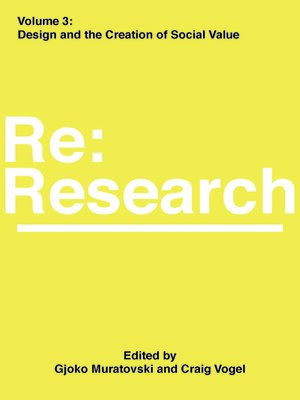Design and the Creation of Social Value
ebook ∣ Re: Research, Volume 3 · Re:research
By Gjoko Muratovski

Sign up to save your library
With an OverDrive account, you can save your favorite libraries for at-a-glance information about availability. Find out more about OverDrive accounts.
Find this title in Libby, the library reading app by OverDrive.



Search for a digital library with this title
Title found at these libraries:
| Library Name | Distance |
|---|---|
| Loading... |
Just as the term design has been going through change, growth and expansion of meaning, and interpretation in practice and education – the same can be said for design research. The traditional boundaries of design are dissolving and connections are being established with other fields at an exponential rate. Based on the proceedings from the IASDR 2017 Conference, Re:Research is an edited collection that showcases a curated selection of 83 papers – just over half of the works presented at the conference. With topics ranging from the introduction of design in the primary education sector to designing information for Artificial Intelligence systems, this book collection demonstrates the diverse perspectives of design and design research. Divided into seven thematic volumes, this collection maps out where the field of design research is now.
Understanding Everyday Design
The more society gets complicated and developed, the more demand for various products. As a result, we are living in a flood of various products. However, considering how people consume and use products in their daily life, it is not difficult to find people transforming, changing the original purpose or adding value to existing products instead of buying new ones. This phenomenon has been defined as everyday design. In a sense that everyday design provides a better understanding of actual uses in real context, it deserves to be studied. Therefore, this paper attempts to figure out an underlying mechanism of everyday design. For this, a conceptual framework was developed, whose focus was on what triggers everyday design, what goals are set and how a product is transformed. The conceptual framework was validated with a photographic inventory of users' everyday design in our daily life. The conceptual framework could provide a better understanding of everyday design in a systematic way. If it is considered in the product development process, it could contribute to an increase of use satisfaction as well as sustainable design. The limitations and a further study are discussed at the end of the paper.
Social Value Creation through Multidisciplinary Design Education
The paper proposes that design with a multidisciplinary student cohort as active partners can play the role of bringing the four different stakeholder groupings, namely, government, industry, society and academia together within the creative consortia, and create innovation for the greater good of the society. By studying a selection of social innovation projects undertaken by multidisciplinary student teams as connector-integrators, which engaged with companies, government bodies and community groups, we have examined a combination of "four" different activities across different economic and cultural (human experience) contexts to assess their different degrees of appropriateness in creating future value. We apply these methods to establish "creative consortia," which has enabled us to reframe the context of the problem space. We believe that the creative consortia has the potential to create more relevance in the solution space, greater engagement in realizing the proposition into the future and a higher opportunity for integration of such future principles into emerging government policy, and national innovation agendas.
Taking Aim at "wicked problems": A Practical Philosophy for Educating Designers in the Making of Wise Decisions
Today's design pedagogies lack the characteristics for redressing...







